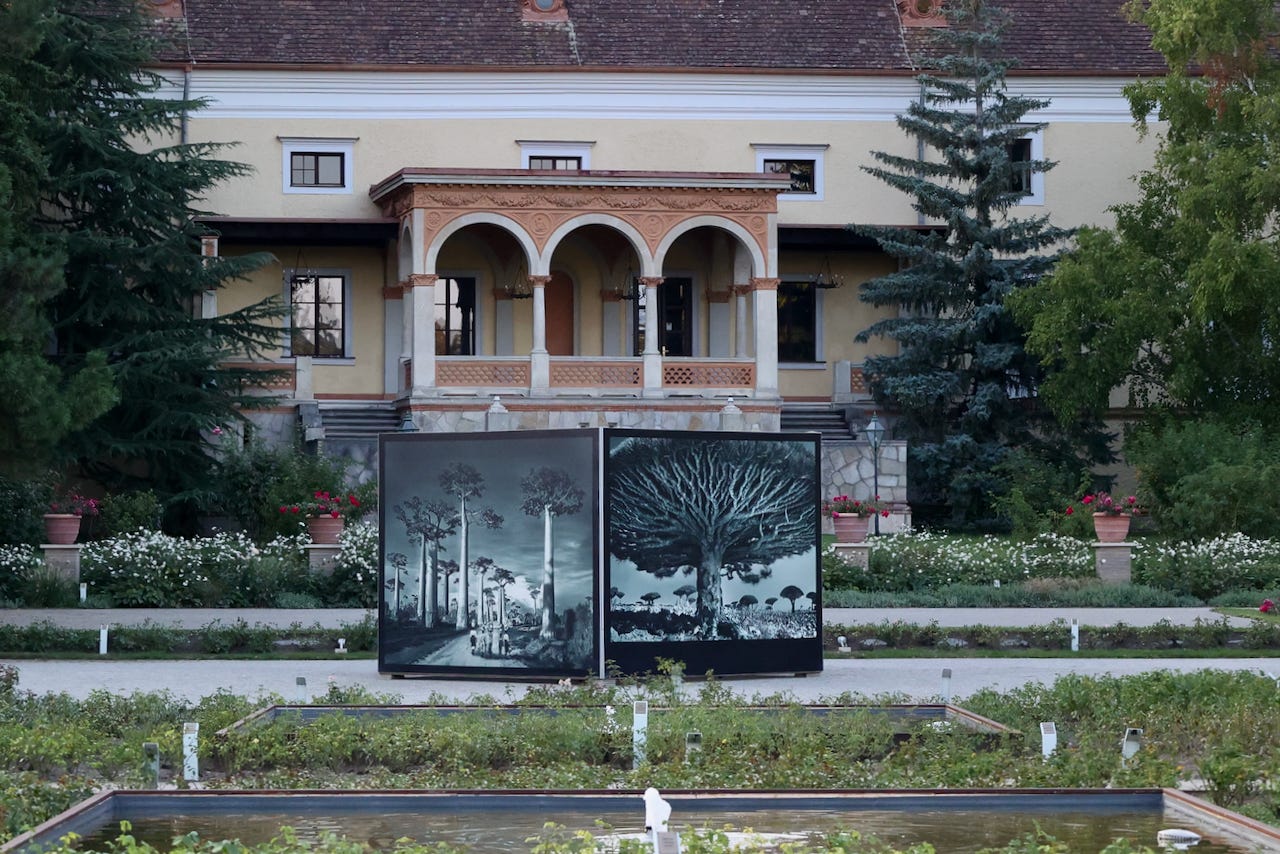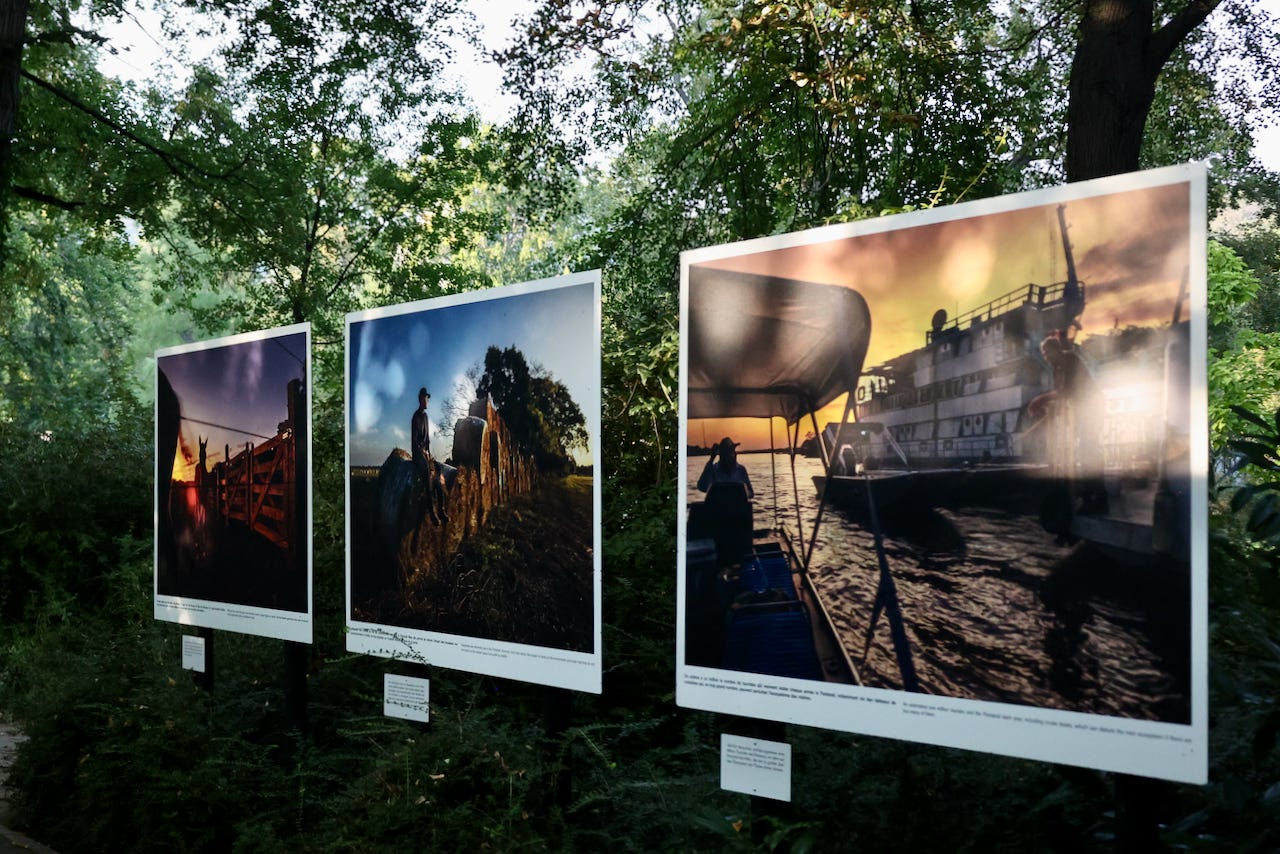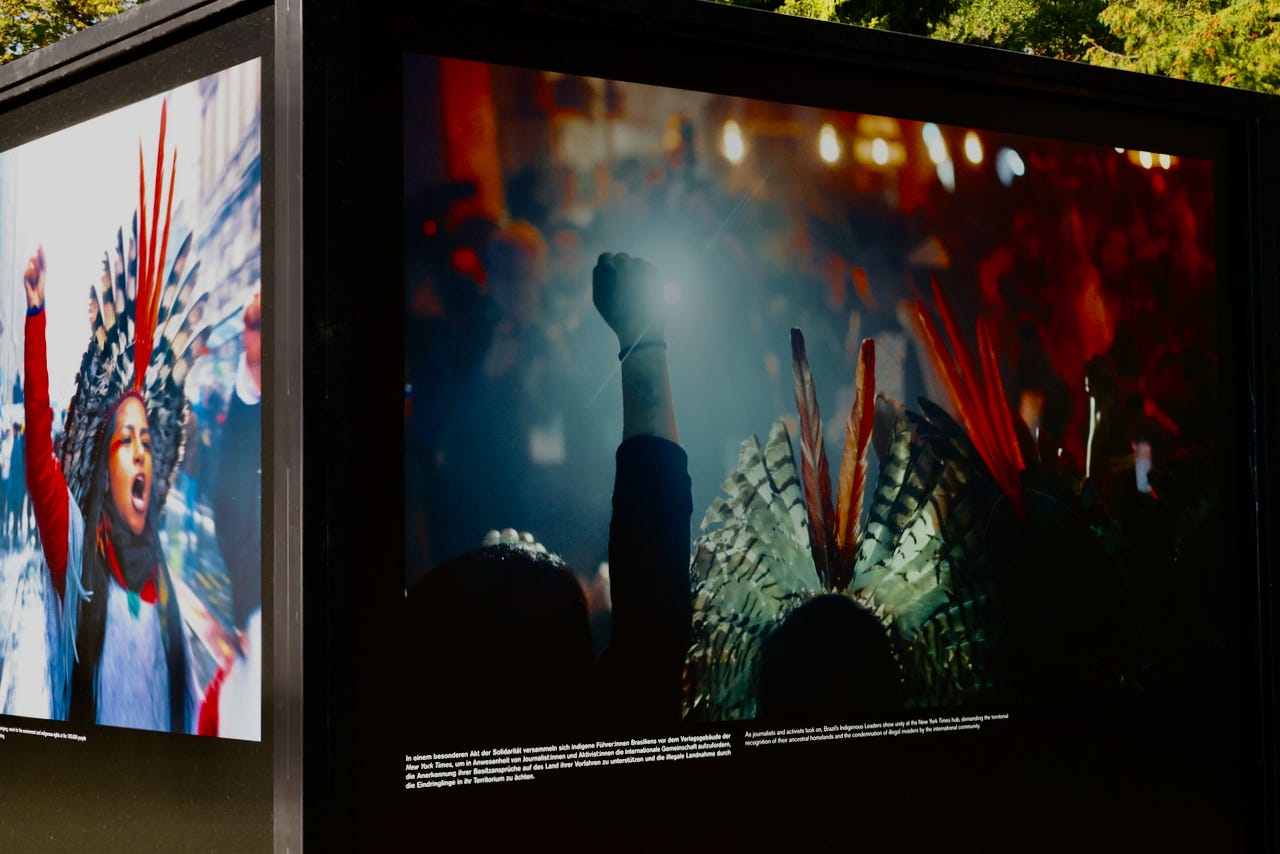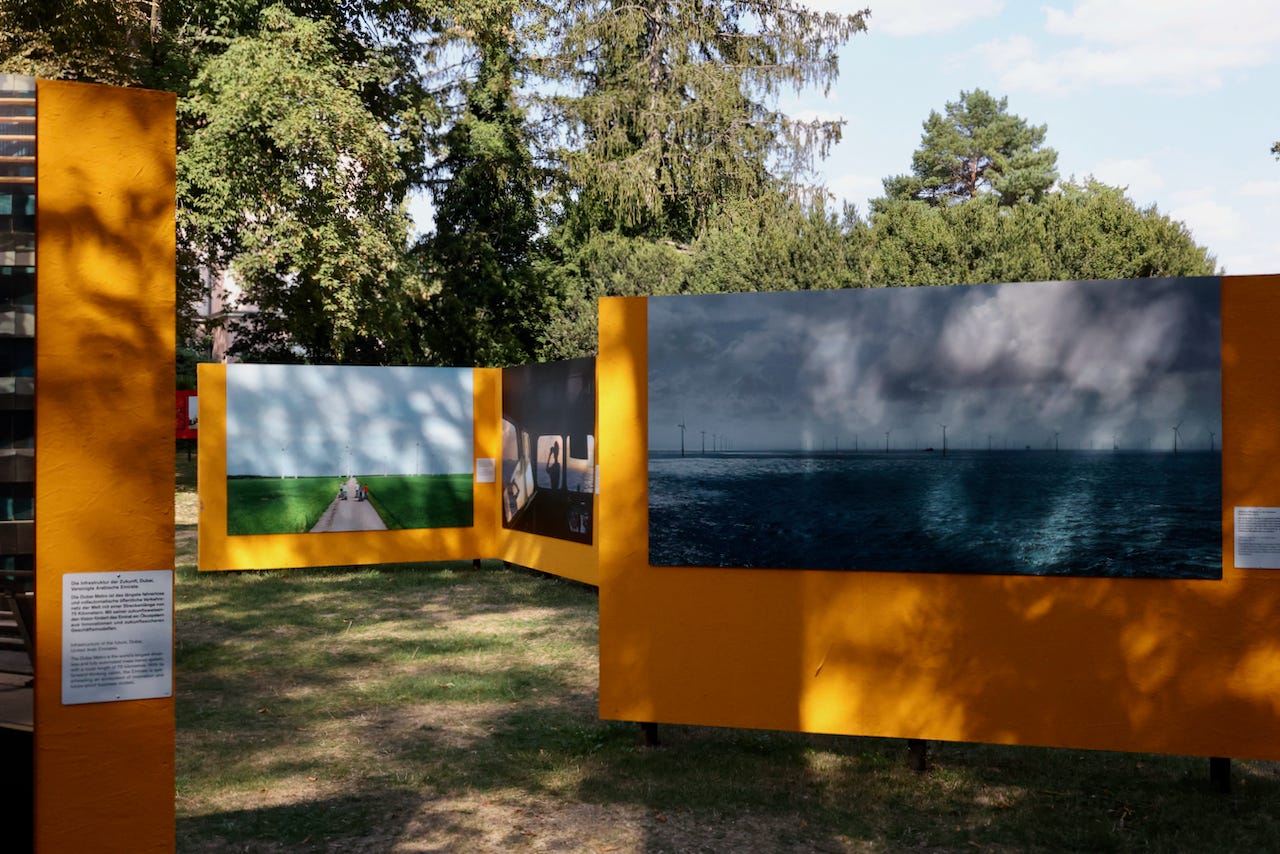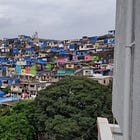FROM THE EDITOR’S DESK
WorldWise reader—
In late August I got to spend a couple of days in the Austrian town of Baden, immersed in imagery captured by a select group of acclaimed photographers. The exhibition was lightly curated to explore different facets of the state of life on this planet, and today’s post brings you a small sample of that work alongside a thought-bubble that emerged from the weekend’s visuals and discussions.
There’s a lot to catch-up on after the break, so let’s get straight to it—read on for the dispatch, a media briefing and a note on my latest feature.
Anita
INSIGHT | views & analysis
A focus on the interface.
The cinema screen filled with vibrant colours—every shade of blue you can imagine and even those you could not, water teeming with ocean life, captured by a lens holding our gaze suspended on that interface between the surface and what lies beneath.
Underwater photographers Jennifer Hayes and David Doubilet were our guides through “two worlds: above and below the sea”. Their partnership, with National Geographic assignments that span five decades, masters complex logistics and risk to bring to light our “planet ocean”, as Doubilet calls it, where humans rarely tread.
Jennifer Hayes takes us behind the scenes with stories from the making of The Generous Gulf.
—
This was Festival La Gacilly - Baden Photo in Baden, Austria—Europe’s largest open-air photo festival, which runs from 13 June to 13 October, showing some of the best environmental photography.
Hayes and Doubilet were on stage to kick off an event for the Media. And by the end of their segment you could sense in the audience that something had moved. I’d turned to my colleague in the next seat, ready for commentary, but she was still immersed in that ocean world, not yet ready to come up for air.
This work should be in every school curriculum, Johanna from the organising team told me in words to that effect when it came to the time for speaking.
I nodded in agreement, but eventually settled on a different thought.
—
Doubilet and Hayes’ work speaks to this year’s festival theme, ‘Nature as Heritage’.
It also speaks to loss. The visuals and sounds they record bring us closer to remote corners of nature, some now fading away. On occasion, symbols of the human activity that drives that destruction hover almost menacingly in the background.
The following images are a case in point, made by the photographers after travelling to the exact same location about a decade apart.
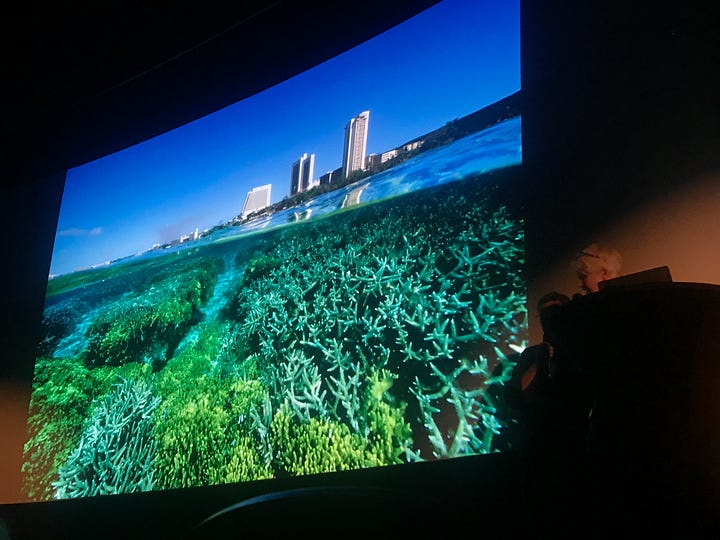

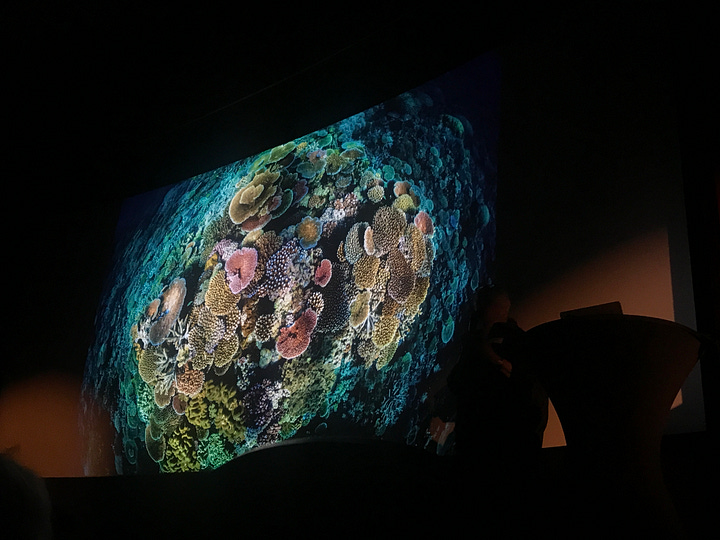

On more solid ground stand the remarkable trees chosen by photographer Beth Moon to be her subjects—figures of survival against the odds, asserting their magnificence.
Jaguars and Blue Macaus are among the rare or endangered species captured in Brent Stirton’s photographs of the Pantanal Nature Reserve in Brazil. The world’s largest wetland remains vulnerable to fires, infrastructure projects and agricultural expansion—a human presence also documented in this work.
For years now, Indigenous communities have been fighting their corner—photographs by director and cinematographer Richard Ladkani feature some of those risking their lives to defend and protect the Amazon rainforest.
And in Luca Locatelli’s work, the exhibition explores how imagery once labelled futuristic is taking shape before our eyes through technology—exposing the new landscapes humans are creating in the name of progress.
—
This is a festival that wears its heart on its sleeve. The aspiration is to help make the world a better place in a small way, says Lois Lammerhuber, photographer and curator of the Austrian exhibition, who believes that photography is under-appreciated in its potential to help do that. He writes:
On the fundamental issues of urbanisation, biodiversity, natural resources, environmental pollution and global warming, we will try to use images to provide, if not solutions, then at least food for thought.
And so I was left with this thought:
What if business leaders were in the room—those whose development decisions fuel the problems that erode nature’s diversity and colour: what if they came face to face with the wonder and the damage. Would they be more inclined to account for the environmental cost—that to which you can assign a dollar value and that which you can't? Could it be an incentive to try just that little bit harder to invest in development in a way that preserves and values non-human life?
I remember attending a meeting about mining critical minerals at a London think-tank last year. It was a mixed crowd but one decidedly made up of institutions focused on meeting the growing need to supply ‘green energy’. And while sustainability featured prominently in the conversation, environmental and community concerns were seen as ‘treehugger’ preoccupations at worst, marginal issues at best: regulatory hurdles to overcome to get on with the real business of powering the global economy.
It’s just one example of many conversations about investment in development projects which are held with economic concerns at the centre of the frame.
Different communities, same scenario. Most of us sit in our comfort zones, clinging to worldviews, preaching to the converted—when perhaps change can only begin to happen if we risk tension and invite each other into the room; if we dare to take each other’s wants and needs seriously; if we can stay suspended long enough at the interface between worlds.
PS: If you have an experience or anecdote to share of a fruitful coming together of business and environmental communities, I’d love to hear it.
RELATED | from the archive
GLOBAL BRIEFING | around the world
Highlights
🗞 A number of upgraded bilateral partnerships were announced at the latest Forum on China-Africa Cooperation earlier this month. The event highlights China’s emergence as a development leader on the continent and beyond, having invested through its Belt and Road Initiative and handed out loans with attractive terms, according to analysis by the editors of World Politics Review. The ONE Campaign’s latest Aftershocks newsletter also offers a take on the Forum and the China-Africa relationship.
🗞 Two pieces report on how the livestock and meat industries appear to hold sway over organisations that should be holding them accountable for climate impacts—Arthur Neslen writes for Climate Home News that the UN’s food agency has failed to recommend curbing animal farming responsible for methane emissions, while Kenny Torrella’s analysis for Vox suggests that two major environmental NGOs are supporting the meat industry’s ‘greenwashing’.
🗞 Can basic income be effective as a policy to protect rainforests? An NGO is testing whether providing Peruvian Indigenous communities with a basic income with no strings attached can both improve their lives and protect the rainforest, reports Graeme Green for The Guardian.
🗞 Construction of Indonesia’s new capital is misguided, critics say. The ‘Nusantara’ development, which is underway on the island of Borneo, has cleared mangrove forests that host threatened wildlife, despite repeated claims that the project will be “green”, report Hans Nicholas Jong for Mongabay & Adi Renaldi for Context. It’s “a giant vanity project doomed to fail”, according to The Economist.
🗞 India is making a ‘bioeconomy’ push with a new policy to invest in “high-performance biomanufacturing”, which aims at a move away from chemical-based industries and towards developing bio-based products with minimal carbon footprints, Sahana Ghosh & Subhra Priyadarshini report for Nature.
🗞 Development lessons from Bangladesh. The country’s recent political unrest after years of progress now serves as a lesson for other emerging economies on why development doesn’t work over the long term, Catherine Davison reports for Devex.
🎙 There’s a popular fruit at the root of deforestation and water shortages in Mexico according to Daniel Wilkinson, senior policy adviser at Climate Rights International. He discusses the role of booming demand for avocados in the United States, and the profit that comes with it, in an interview by Stephanie Sy for PBS.
Ideas of note
💡 Solar farms can become two solutions in one—As well as providing low-carbon electricity, they can boost local pollinator populations, support nearby crops and provide multiple ‘ecosystem services’, write Bill McKibben for The New Yorker and Fabio Carvalho & Alona Armstrong in The Conversation.
💡 Technology is not enough—The global climate is changing much faster than the pace of any cultural or technological transformation that could curb it, argues Nathan Gardels, editor-in-chief of Noema Magazine.
We are only buying time if we don’t also address what drives the system — the upstream overconsumption that turns every want into a need that can only be satisfied through a net increase in the use of planet-warming energy. In the end, what we don’t do is as much a part of the equation as what we do.
💡 There’s no such thing as a pure wilderness—In her new book Nature’s Ghosts, journalist Sophie Yeo argues that people have always been a part of nature, have left a mark even in the most isolated places, and should be included in future visions of the natural world, writes Douglas H. Erwin in a book review for Nature.
💡 A push to make ecocide a crime—The Pacific Islands of Vanuatu, Fiji and Samoa have submitted a proposal to the international criminal court to class environmental destruction as crime alongside genocide, reports Fiona Harvey for The Guardian.
In other news
🔥 On extreme heat
This summer was the hottest in recorded history around the world, Sarah Kaplan writes in The Washington Post.
This year’s brutal summer in the Middle East suggests the region is on its way to becoming uninhabitable, according to analysis by Steven A. Cook and Christina Bouri for Foreign Policy.
Katarina Höije reports for Bloomberg on a UN estimate that almost 500 million children born today will experience double the number of extremely hot days than their grandparents’ generation.
🪫 On the energy transition
Despite a history of destruction caused by copper mining, people are “stealing, fighting, and dying” to feed a growing demand, Vince Beiser writes for WIRED.
India is planing to offer research institutes funding to give technical assistance to the mining industry as an incentive for extraction of critical minerals, Neha Arora reports for Reuters.
Also for Reuters, Fabian Cambero reports on a study showing that lithium mining is slowly sinking Chile's Atacama salt flat.
🌱 On environmental protection
Latin America is still the most dangerous place for people working to protect the environment, according to Global Witness estimates showing that almost 200 defenders were killed last year, report AFP & Patrick Greenfield for the Guardian.
Droughts and fires across parts of the Amazon are causing alarm as rare wildlife perish and rivers dry up, report Ana Ionova for The New York Times, Tom Phillips for The Guardian, and AFP.
In the lead-up to the COP16 biodiversity summit in Colombia, officials are raising awareness of how restoring nature is as important as curbing climate emissions, write Patrick Greenfield for The Guardian and Stella Paul for Inter Press Service.
🦠 On global health
The WHO and Africa’s CDC have declared mpox a public health emergency as scientists say the new clade Ib strain is spreading faster than expected, vaccines are slow to roll out to affected countries on the continent, and critics decry a sense of déjà vu at the shortfalls of the global response, according to multiple reports including by Jess Craig for Vox, Jennifer Rigby and Julie Steenhuysen for Reuters and a comment by Janeen Madan Keller and Javier Guzman for Health Policy Watch.
The WHO’s Latin American office is alerting the region to a higher risk from the rare Oropouche virus after reports of stillbirths in Brazil, write Lisa Schnirring for CIDRAP, Verity Bowman & Maeve Cullinan for The Telegraph, and Onur Erem, André Biernath & Richard Gray for BBC Future.
Cholera and diseases carried by insects are rising globally, report UN News and Tina Reed & Alison Snyder for Axios.
🕸 YOUR SUPPORT MATTERS
A big thank you to those of you who continue to support my time and energy for the project with a paid subscription. If that’s not an option for you, consider showing support with a tap on 🤍 which flags the post for others, or simply spread the word with your networks 📲
UPDATE | from the network
It's over halfway through a landmark election year. Put that together with rising political polarisation, and we may have a public health problem. After Donald Trump was voted into the White House in 2016, "post-election stress disorder" entered the mental health lexicon. As politics continues to become more divisive, pervasive and personal—whether online or offline, in the United States or in other parts of the world—the discord is finding its way into clinics and therapy rooms. My latest, for Nature Medicine.
PS.
Thank you.
WorldWise is read across 67 countries—it remains independent thanks to the support of subscribers like you, and to the rest of my nomadic work-life. Sign up | Browse archive | Sponsor an issue
Created and edited by Anita Makri—journalist/writer, producer and editorial adviser covering global development and science in society. I also help selected organisations with compatible values to strengthen their media work. LinkedIn | Instagram | Email




